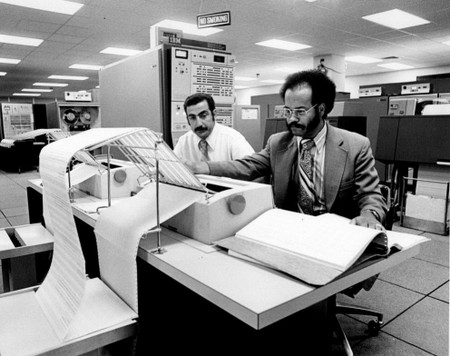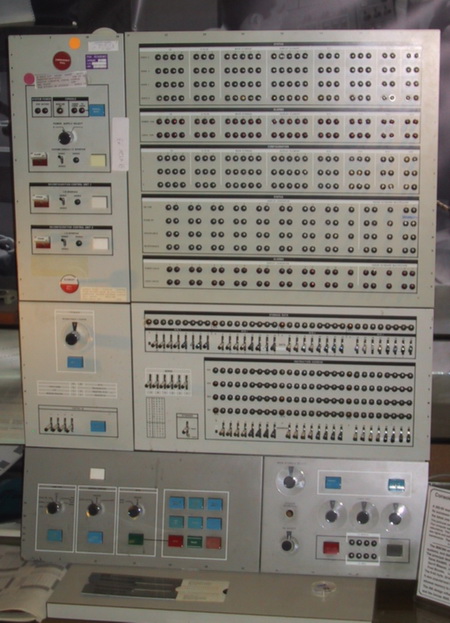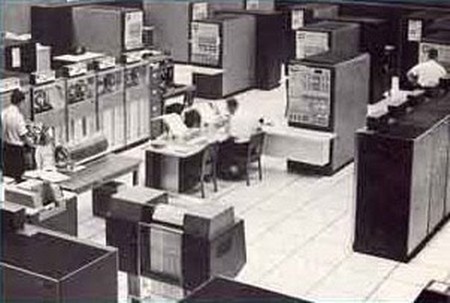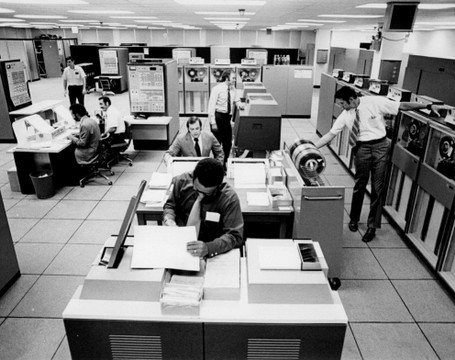Big Iron - The IBM 9020 Multi-Processor System | ||
Rick's Story With The IBM 9020 The IBM 9020 was the great-grandfather of enroute automation and its heart and soul. This was the "Big Kahuna" of mainframes and remained in operation for almost 25 years. Unlike standard IBM mainframes of the day, the 9020 was designed to operate in "real time": that is, to compute and generate results as fast as or faster than data were fed into it. By the mid-1970s, the FAA had achieved an ATC system based on a marriage of radar and computer technology. By automating certain routine tasks, the system allowed controllers to concentrate more efficiently on the vital task of providing aircraft separation. Data appearing directly on the controllers’ scopes provided the identity, altitude, and groundspeed of aircraft carrying radar beacons. The system took control of flight and radar data processing (with the Computer Display Channel) and alleviated the controller from mundane tasks. If you've ever had to forward flight plans manually, process flight strips by hand or push a shrimp boat across a horizontal display, then you know what I'm talking about. Although the 9020 is long gone and replaced by two different iterations of hardware, I still have fond memories of these boxes. I was sent to the FAA Academy in 1986 for six months of training on this system. I quickly lost my love affair with the 9020 and it's antiquated architecture. Most IBM 360 systems had been discontinued for well over a dacade. We were still using punched cards for input. I think we were the last people on the planet still using these. This is like using an abacus to do your taxes. I hated adaptation but loved programming in BAL (Basic Assembler Language) and JOVIAL (Jules Own Version of the International Algorithmic Language). I found JOVIAL similar to FORTRAN (with which I had previous experience) and excelled with this table structured language. Our class programming projects were ridiculously simple so I challenged myself with stupid utilities that interacted with the control panels. I was in the last few weeks of this training when I received a call from the facility manager. This was highly unusual and I didn't know what to expect. The function of the automation and training departments were to be removed from the government and contracted out to private companies; I was officially in limbo. Wow! What a waste of time and training. I was offered a job with the automation contractor but had no interest in leaving the FAA. The facility manager wanted me in the Quality Assurance shop, but if I couldn't code the "Big Iron," I wanted to push metal. So I dusted off my headset and back to the trenches I went. | ZMA IBM 9020 Aug 26, 1975 The commissioning of the computerized Radar Data Processing system (RDP) at ZMA marked the end of the final phase of the completion of NAS En Route Stage A, FAA's program of automating and computerizing the nation's en route air traffic control system, an effort covering more than a decade. Miami was the last of the 20 ARTCCs to receive RDP capability. I never saw a computer operator in a coat and tie. I suspect the dress was mandated for the press picture.  ZMA c1975 Input at the system's 1052 terminal | |
What is an IBM 9020 | ||
 IBM 9020 Master Panel  | The IBM 9020 refers to IBM System/360-family computers configured into a multiprocessor system for use by the FAA for Air Traffic Control. Systems were installed in the FAA's 20 enroute Air Route Traffic Control Centers, beginning in the late 1960s. The IBM 9020A, for example, was based on the System 360/50 and the 9020D used 2 out of 3 or 4 360/65 processors for flight and radar data processing with 2 out of 3 360/50 processors providing input/output capability. A maximum configuration CCC/DCC complex contained 12 IBM S/360 mainframes. Not all FAA ARTCCs, of which there were 20 had the maximum configuration. There were three operational variants of the 9020 system: 9020A CCC (Central Computer Complex); 9020D CCC; and 9020E DCC (Display Channel Complex). All the 9020A CCCs were attached to a Raytheon-built display system (CDC) while the 9020D CCCs could be attached to either a CDC or to the IBM 9020E DCC. The 9020A and 9020D CCCs carried out flight and radar data processing but needed an attached display complex to provide a digital display to the air traffic controllers. Each ARTCC had a System Maintenance Monitor Console (SMMC) that brought together the status indications of the installed 9020 system(s) as well as related components, such as environmental systems and communications links. The 9020As and 9020Ds were in service until 1989 when they were finally replaced by IBM 3083 BX1 mainframes as part of the FAA's HOST upgrade. The 3083s in turn were replaced with IBM 9672 RA4 parallel processing servers during the FAA's Host and Oceanic Computer System Replacement (HOCSR) completed in 1999. One reason for the 1999 upgrade was concern, probably unfounded, that the IBM 3083's microcode would not operate properly in the year 2000. At least during the first phase of the upgrade, the 9672s were running the FAA's original assembly language and JOVIAL code in System/360 emulation mode. Because of the failure of the FAA's Advanced Automation System (AAS) project, operation of the 9020E Display Channel Comlexes was pushed well into the 1990s | |
Big Iron - Ricks Career With ATC
Rick's Career
With Air Traffic Control

Rick's Career With ATC
